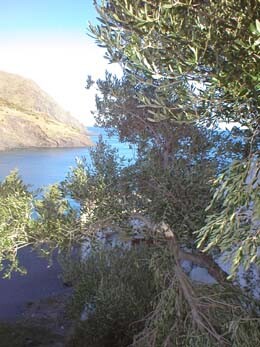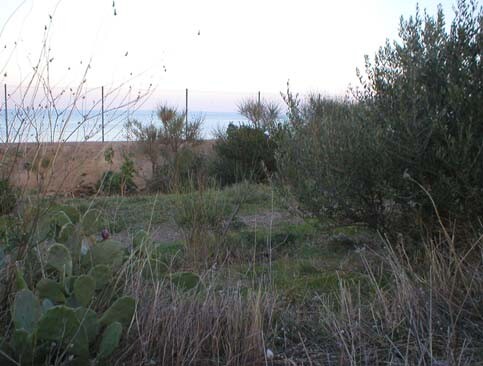The Electronic Intifada 20 December 2004
When the Nobel Committee announced its decision to award its 2004 Peace Prize to an environmental activist best known for planting trees, more than a few observers raised their eyebrows. After all, isn’t the world’s most prestigious peace prize typically reserved for those who have a direct hand in resolving armed conflict? More cynically, isn’t it often given to those who resolve conflicts only after spending years starting and perpetuating them?

A Portbou vista (photo by John Collins)
Amidst such a global crisis, what is the world’s only superpower up to? The day before Wangari Maathai accepted her Nobel Prize, the U.S. Congress passed legislation authorizing the Federal Aviation Administration to issue permits for space tourism. The Bush administration, moreover, continues to talk hopefully about the future colonization of Mars.
Americans, it seems, are keen to escape the grassroots at any cost.
Israel’s “war on the milieu”
For much of the rest of the world, however, the importance of defending trees is self-evident, for it is a matter of life and death. Palestinians know this as well as anyone. Since the advent of the Israeli occupation in 1967, Palestinians have seen Israeli machines uproot hundreds of thousands of olive trees, each one a tangible source of livelihood and identity for a family, a village, a nation. According to Nadia Hijab, executive director of Washington, DC’s Palestine Center, more than 360,000 olive trees have been uprooted since 2000 alone.
There are other, equally ecological reasons why Palestinians might have cheered the selection of a grassroots activist for the Nobel Peace Prize. The past four years have seen a continuation of Israel’s policy of home demolitions, with hundreds of Palestinians rendered homeless in the face of the infamous D-9 Caterpillar bulldozers that mete out collective punishment and pave the way for Israel’s apartheid wall. The Israeli human rights group B’Tselem reports that over a thousand Palestinian homes have been demolished since the start of the first intifada in 1987. Israel’s policy of expropriating land and water resources from under the feet of Palestinians falls into the same category.
The devastating material effects of these policies are compounded by their powerful symbolic impact. The olive tree, after all, is the symbol of the Palestinian people and a dominant metaphor in their national literature. The home, needless to say, has a particular iconic importance for a people who have been dispossessed and dispersed across the globe. The same can be said of water, a precious resource and symbol of life in a part of the world where it is often scarce. In this sense, environmental assaults are also assaults at the level of the national imaginary.
Paul Virilio, the French social theorist and war historian, has a useful term for the sort of state violence that Israel is pursuing: “war on the milieu.” According to Virilio, the classical model of waging war is increasingly being replaced by a model of perpetual counterinsurgency, in which war happens not in a strategic arena, but on it. Within such a model, war is waged directly on civilians and on the natural and built environment that ensures their survival.
In Virilio’s subtle change of preposition, we find an important clue to understanding Israel’s policy in the occupied territories. As the late Edward Said was fond of pointing out, the Zionist/Israeli colonization of Palestine has always been a policy of extraordinary detail symbolized by Chaim Weizmann’s mantra, “another acre, another goat.” Israeli policy, in other words, has its own (colonial) ecology rooted in the careful and systematic attempt to manage the natural and built environment to its own advantage — and if necessary by destroying it. Israel is thus an excellent example of what Virilio calls a “suicidal state.”
Israel is hardly unique in pursuing such policies (though one might argue that it has been unusually single-minded in doing so). Placed in historical context, the assault on the Palestinian people’s very means of survival recalls a wide historical range of U.S. actions including the near-destruction of the buffalo (symbol of North America’s indigenous population), the defoliation of Vietnam, the bombing of water treatment facilities in Baghdad, and the dropping of graphite bombs to create widespread blackouts in Yugoslavia.
Some may argue, therefore, that Israel is simply the Middle Eastern equivalent of the settler-colonial United States, carrying out its own “errand in the wilderness” and religiously opposing indigenous popular mobilization of any kind. Others, perhaps more daringly, may suggest that it is the U.S. that has learned from Israel. In reality, both perspectives are correct, for what we are witnessing in the U.S.-Israeli relationship is a kind of state terroristic feedback loop whose results we witness daily in Palestine, Iraq, and elsewhere.
The struggle for the milieu
With all of this in mind, it is hardly surprising that during the second intifada, more and more Palestinians have found themselves facing Israeli soldiers not only in the streets (which were the prototypical site of confrontation during the first intifada), but also in their homes, in their fields, under their trees. The conflict has reached such a stage that Palestinians are now relying on what is perhaps their last and most basic source of power: the power to exist and to inhabit space.
As regular readers of the Electronic Intifada are well aware, the mainstream U.S. media have played a key role in hiding the reality of this situation. While they focus (and encourage us to focus) on occasional acts of spectacular violence and on the theatrical machinations of the “peace process,” the daily struggle of Palestinians to survive, and to defend the place that is their home, continues. The overall effect is to hide from view not one but two occupations: Israel’s illegal military occupation of the West Bank and Gaza, and Palestinians’ stubborn, human occupation of the same.
Despite the shameful negligence of the major news media, however, the word about what is happening in Palestine continues to filter out through the efforts of activist networks and enterprising independent journalists. In this sense, Israeli policy has a deeply global significance. It is no accident, for example, that Ariel Sharon’s own “war on the milieu,” which reached its apotheosis in his 2002 Operation Defensive Shield, has coincided with an upsurge in global solidarity with Palestinians.
The solidarity activists who continue to join Palestinians on the ground undoubtedly come from a variety of backgrounds, yet in their actions, all share what amounts to an ecological sensibility. Helping Palestinians harvest their olives, putting their bodies on the line to prevent house demolitions, aiding pregnant women at checkpoints—all of these constitute ecological responses to a set of policies that have effectively criminalized the stuff of everyday life.
Learning from the milieu

Sabr cacti and olive trees in Portbou (photo by John Collins)
The memorial, titled “Passages” and created in the 1990s by Israeli sculptor Dani Karavan, includes a long, partially covered stairway leading down from the town cemetery to the Mediterranean below. A lesser known element of the piece is a small olive tree located next to one of the cemetery’s outer walls. In the context of Benjamin’s tragic story, the tree represents life in a world of death, rootedness in a world of displacement. That it also represents Palestine is an interesting irony, especially given that Benjamin repeatedly refused the entreaties of his good friend, Gershom Scholem, to leave Europe and join the wave of Jews moving to Palestine as part of the Zionist project.
Equally interesting is the fact that the hilltop that hosts Karavan’s monument is covered with olive trees that freely mingle with prickly pear cactus—the same cactus that has been adopted by many young, native-born Israeli Jews (sabras) as a symbol of their identification with the land. That many of the soldiers who engage in the uprooting of olive trees are themselves sabras only demonstrates the ideological confusion and material recklessness of the Israeli state.
Conventional wisdom would have us believe that the prickly pear and the olive tree cannot coexist and must either engage in an endless zero-sum fight to the death or else separate themselves hermetically from each other. The hilltop in Portbou suggests otherwise. It insists on the possibility and the ecological sense of coexistence, and it testifies to the folly of those who would wage “war on the milieu.”
John Collins is Assistant Professor of Global Studies at St. Lawrence University. He is the author of Occupied by Memory: The Intifada Generation and the Palestinian State of Emergency, published by New York University Press (2004) and the co-editor of Collateral Language: A User’s Guide to America’s New War (NYU Press, 2002).





